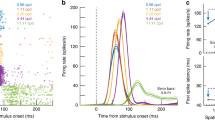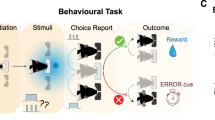Abstract
Animal studies have shown that the superior colliculus (SC) is important for synthesising information from multiple senses into a unified map of space. Here, we tested whether the SC is a critical neural substrate for multisensory spatial integration in humans. To do so, we took advantage of neurophysiological findings revealing that the SC does not receive direct projections from short-wavelength-sensitive S cones. In a simple reaction-time task, participants responded more quickly to concurrent peripheral (extra-foveal) audiovisual (AV) stimuli than to an auditory or visual stimulus alone, a phenomenon known as the redundant target effect (RTE). We show that the nature of this RTE was dependent on the colour of the visual stimulus. When using purple short-wavelength stimuli, to which the SC is blind, RTE was simply explained by probability summation, indicating that the redundant auditory and visual channels are independent. Conversely, with red long-wavelength stimuli, visible to the SC, the RTE was related to nonlinear neural summation, which constitutes evidence of integration of different sensory information. We also demonstrate that when AV stimuli were presented at fixation, so that the spatial orienting component of the task was reduced, neural summation was possible regardless of stimulus colour. Together, these findings provide support for a pivotal role of the SC in mediating multisensory spatial integration in humans, when behaviour involves spatial orienting responses.





Similar content being viewed by others
References
Birch J, Barbur JL, Harlow AJ (1992) New method based on random luminance masking for measuring isochromatic zones using high resolution colour displays. Ophthalmic Physiol Opt 12:133–136
Bolognini N, Frassinetti F, Làdavas E (2005) Acoustical vision of below threshold stimuli. Interaction among spatially converging stimuli. Exp Brain Res 160:273–282
Bolognini N, Savazzi S, Bricolo E, Marzi CA, Maravita A (2007) The role of superior colliculus in audio-visual integration in humans: clues from the redundant target effect. Annual Meeting of the Cognitive Neuroscience Society, New York City. Annual Meeting Program, 51
Brainard DH (1997) The Psychophysics toolbox. Spat Vis 10:433–436
Burnett LR, Stein BE, Perrault JT Jr, Wallace MT (2007) Exitotoxic lesions of the superior colliculus preferentially impact multisensory neurons and multisensory integration. Exp Brain Res 179:325–338
Bushara KO, Hanakawa T, Immisch I, Toma K, Kansaku K, Hallett M (2003) Neural correlates of cross-modal nbingding. Nat Neurosci 6:190–195
Calkins DJ (2001) Seeing with S cones. Prog Retin Eye Res 20:255–287
Calvert GA (2001) Crossmodal processing in the human brain: insights from functional neuroimaging studies. Cereb Cortex 11:1110–1123
Calvert GA, Spence C, Stein BE (2004) The Handbook of Multisensory Processing. MIT Press, Cambridge, MA
Calvert GA, Thesen T (2004) Multisensory integration: methodological approaches and emerging principles in the human brain. J Physiol Paris 98:191–202
Dacey DM, Lee BB (1994) The “blue on” opponent pathway in primate retina originates from a distinct bistratified ganglion cell type. Nature 367:731–735
de Monasterio FM (1978) Properties of ganglion cells with atypical receptive-field organisation in the retina of macaques. J Neurophysiol 41:1435–1449
Frassinetti F, Bolognini N, Làdavas E (2002) Enhancement of visual perception by crossmodal audio-visual interaction. Exp Brain Res 147:332–342
Frassinetti F, Bolognini N, Bottari D, Bonora A, Làdavas E (2005) Audiovisual integration in patients with visual deficit. J Cogn Neurosci 17:1442–1452
Holmes NP, Spence C (2005) Multisensory integration: space, time and superadditivity. Curr Biol 15:762–764
Hughes HC, Reuter-Lorenz PA, Nozawa G, Fendrich R (1994) Visual-auditory interactions in sensorimotor processing: Saccades versus manual responses. J Exp Psychol Hum Percept Perform 20:131–153
Ignashchenkova A, Dicke PW, Haarmeier T, Their P (2004) Neuron-specific contribution of the superior colliculus to overt and covert shifts of attention. Nat Neurosci 7:56–64
Jiang W, Jiang H, Stein BE (2002) Two corticotectal areas facilitate multisensory orientation behavior. J Cogn Neurosci 14:1240–1255
Jiang W, Jiang H, Rowland BA, Stein BE (2007) Multisensory orientation behavior is disrupted by neonatal cortical ablation. J Neurophysiol 97:557–562
Kadunce DC, Vaughan JW, Wallace MT, Stein BE (2001) The influence of visual and auditory receptive field organization on multisensory integration in the superior colliculus. Exp Brain Res 139:303–310
Kustov AA, Robinson DL (1996) Shared neural control of attentional shifts and eye movements. Nature 384:74–77
Macaluso E, Driver J (2005) Multisensory spatial interactions: a window onto functional integration in the human brain. Trends Neurosci 28:264–271
Maravita A, Savazzi S, Bricolo E, Penati V, Marzi CA (2005) Role of superior colliculus in audio-visual redundancy gain. International Multisensory Research Forum, 6th Annual Meeting, Rovereto, Italy. Abstracts: p 59
Marrocco RT, Li RH (1977) Monkey superior colliculus: properties of single cells and their afferent inputs. J Neurophysiol 40:844–860
McGurk H, MacDonald J (1976) Hearing lips and seeing voices. Nature 264:746–748
Miller J (1982) Divided attention: evidence for coactivation with redundant signals. Cognit Psychol 14:247–279
Miller J (1986) Time course of coactivation in bimodal divided attention. Percept Psychophys 40:331–343
Miller JO, Ulrich R (2003) Simple reaction time and statistical facilitation: a parallel gains model. Cognit Psychol 46:101–151
Miller LM, D’Esposito M (2005) Perceptual fusion and stimulus coincidence in the cross-modal integration of speech. J Neurosci 25:5884–5893
Mollon JD (1982) Color vision. Annu Rev Psychol 33:41–85
Mollon JD (1989) “Tho she kneel’d in that place where they grew.” The uses and origines of primate colour vision. J Exp Biol 146:21–38
Mullen KT, Dumoulin SO, McMahon KL, de Zubicaray GI, Hess RF (2007) Selectivity of human retinotopic visual cortex to S-cone-opponent, L/M-cone-opponent and achromatic stimulation. Eur J Neurosci 25:491–502
Murray MM, Foxe JJ, Higgins BA, Javitt DC, Schroeder CE (2001) Visuo-spatial neural response interactions in early cortical processing during a simple reaction time task: a high-density electrical mapping study. Neuropsychologia 39:828–844
Pelli DG (1997) The Video Toolbox software for visual psychophysics: transforming numbers into movies. Spat Vis 10:437–442
Plat FM, Praamstra P, Horstink MW (2000) Redundant-signals effects on reaction time, response force, and movement-related potentials in Parkinson’s disease. Exp Brain Res 130:533–539
Raab DH (1962) Statistical facilitation of simple reaction times. Trans N Y Acad Sci 24:574–590
Savazzi S, Marzi CA (2002) Speeding up reaction time with invisible stimuli. Curr Biol 12:403–407
Savazzi S, Marzi CA (2004) The superior colliculus subserves interhemispheric neural summation in both normals and patients with a total section or agenesis of the corpus callosum. Neuropsychologia 42:1608–1618
Schiller PH, Malpeli JG (1977) Properties and tectal projections of monkey retinal ganglion cells. J Neurophysiol 40:428–445
Spence C, Driver J (1997) On measuring selective attention to an expected sensory modality. Percept Psychophys 59:389–403
Spence C, Driver J (2004) Crossmodal Space and Crossmodal Attention. Oxford University Press, Oxford
Stanford TR, Quessy S, Stein BE (2005) Evaluating the operations underlying multisensory integration in the cat superior colliculus. J Neurosci 25:6499–6508
Stein BE, Meredith MA (1993) Merging of the senses. MIT Press, Cambridge, MA
Stockman AS, MacLeod DIA, DePriest DD (1991) The temporal properties of the human short-wave photoreceptors and their associated pathways. Vis Res 31:189–208
Sumner P, Adamjee T, Mollon JD (2002) Signals invisible to the collicular and magnocellular pathways can capture visual attention. Curr Biol 12:1312–1316
Sumner P, Nachev P, Vora N, Husain M, Kennard C (2004) Distinct cortical and collicular mechanisms of inhibition of return revealed with S cone stimuli. Curr Biol 14:2259–2263
Sumner P, Nachev P, Castor-Perry S, Isenman H, Kennard C (2005) Which visual pathways cause fixation-related inhibition? J Neurophysiol 95:1527–1536
Todd JW (1912) Reaction to multiple stimuli. Science Press, Oxford, England
Ulrich R, Miller J, Schroter H (2007) Testing the race model inequality: an algorithm and computer programs. Behav Res Methods 39:291–302
Valenza N, Murray MM, Ptak R, Vuilleumier P (2004) The space of senses: impaired crossmodal interactions in a patient with Balint syndrome after bilateral parietal damage. Neuropsychologia 42:1737–1748
Wallace MT, Meredith MA, Stein BE (1992) Integration of multiple sensory modalities in cat cortex. Exp Brain Res 91:484–488
Wallace MT, Meredith MA, Stein BE (1993) Converging influences from visual, auditory, and somatosensory cortices onto output neurons of the superior colliculus. J Neurophysiol 69:1797–1809
White AJR, Wilder HD, Goodchild AK, Sefton AJ, Martin R (1998) Segregation of receptive field properties in the lateral geniculate nucleus of a New-World monkey, the marmoset Callithrix jacchus. J Neurophysiol 80:2063–2076
Zampini M, Torresan D, Spence C, Murray MM (2007) Auditory-somatosensory multisensory interactions in front and rear space. Neuropsychologia 45:1869–1877
Acknowledgments
This work was supported by a PRIN grant from MIUR to Elisabetta Làdavas. We thank all the participants who took part in this study.
Author information
Authors and Affiliations
Corresponding author
Rights and permissions
About this article
Cite this article
Leo, F., Bertini, C., di Pellegrino, G. et al. Multisensory integration for orienting responses in humans requires the activation of the superior colliculus. Exp Brain Res 186, 67–77 (2008). https://doi.org/10.1007/s00221-007-1204-9
Received:
Accepted:
Published:
Issue Date:
DOI: https://doi.org/10.1007/s00221-007-1204-9




